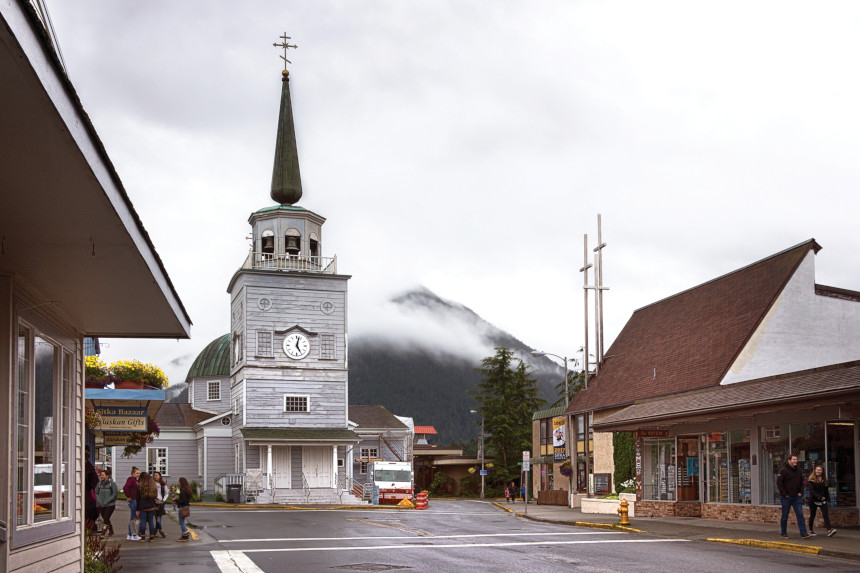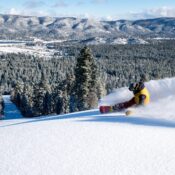When you’re in grizzly country, it’s a good idea to give the hosts a heads-up when paying a visit. Don’t want any awkward moments. So, after our two eight-person skiffs make land, before we even get to the woods, our guides are already shouting “Whoop-whoop!” I join in with “Hey, bears!” feeling the need to make the callout a bit less threatening. After all, it is their territory.
Bushwhacking (rugged hiking without a trail through mud and dense undergrowth, as we’re doing now) is one of several options for passengers on an UnCruise Adventure. There are also plenty of moderate activities, such as kayaking, paddle-boarding, and touring the coastline in small crafts. UnCruise, with its fleet of small (76- to 90-passenger) ships, prides itself on being an alternative to the mega-cruisers that ply the waters of Southeast Alaska. On the big ships, you get an overview of the state’s magnificent wilderness. On the UnCruise, you step into it.
Our voyage began in Sitka, on remote Baranof Island in Southeast Alaska, and would conclude in Juneau. Partly to acclimate to the time zone and partly just to spend a little time on dry land before shipping out, my wife Estelle and I hunkered down on Sitka four days prior to our departure. That’s highly recommended, since Sitka, in its own way, gives you a feel for the remoteness and beauty of Alaska (see sidebar, page 56).
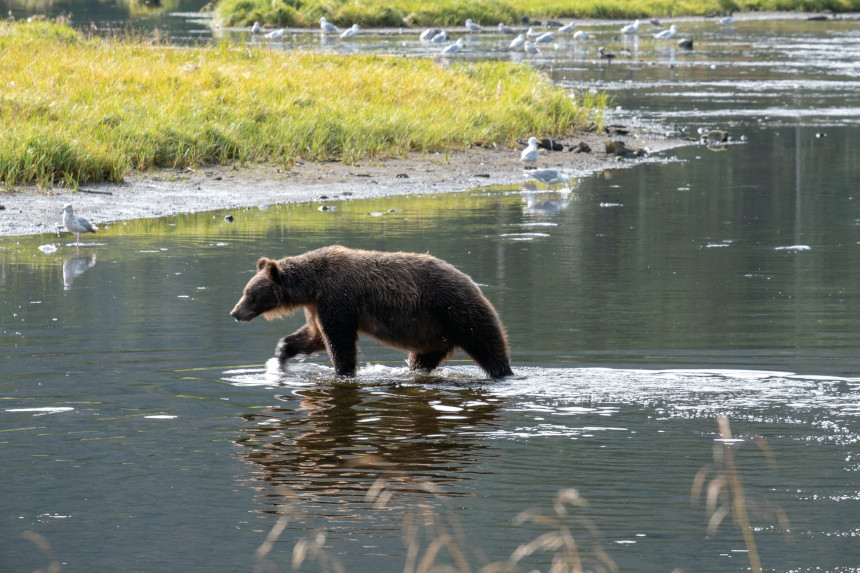
Thanks to all the shouting, we seem to be alone on the shore, but signs of animal activity abound. We stop to study tracks left by deer, wolves, bears. “Still warm!” says our guide excitedly as she hovers her hand inches above some bear scat.
At first it seems impossible to find a way into the woods from the beach thanks to the thick undergrowth at the forest’s edge. But after several false starts, slogging through mud in our knee-high rubber boots, we find a suitable opening, punching through alder and gently pushing aside thorny devil’s club. This leads us first into a cathedral-like conifer forest of Sitka spruce, mountain hemlock, and yellow cedar. There are mosses and lichens underfoot, and thickets of blueberry.
We press on. Suddenly a small, black, cat-like creature pops up in front of us. It’s a marten (of the weasel family). It’s not clear who’s more startled, us or the marten. It freezes, does a double take, then zing! Off it darts, disappearing into the undergrowth.
I wonder if we might surprise a bear in the same way — wishing (just a little) that we will. As the joke goes, you don’t have to run fast if you come across a bear in the wild. Just faster than the next person.
Deeper we go into the dark forest, climbing over fallen logs, pulling ourselves up steep embankments using tree branches for support, when suddenly we come to a large clearing of dense grasses and wildflowers. This, expedition guide Bobby DeMarinis explains, is a muskeg marsh, which forms in low flat areas with poor water drainage. “The water collects and saturates the soil,” he says. “Then oxygen levels decrease in the soil, which also becomes very acidic as needles from conifer trees decompose.”
Spruces and hemlocks tend to die off in these areas, and the result is what looks like a meadow in the middle of the woods. But it’s not like any meadow you’ve ever known. The ground is spongy, the grass thick and deep. DeMarinis identifies the wildflowers as we walk among them — labrador tea, round leaf sundew (a small, delicate flycatcher), shooting stars (featuring beautiful backward-facing petals), and more.
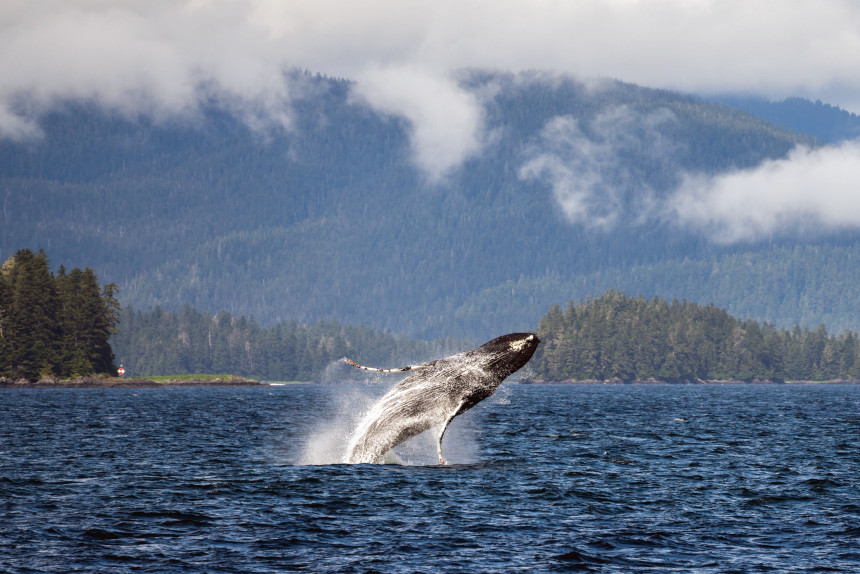
Our ship spends much of each day at anchor. In the evening and at night, it moves along, the gentle rocking ensuring good sleep. Late one afternoon, Estelle and I push off in a kayak from the portable dock lashed to the back of the ship. We paddle softly through placid black water, bald eagles soaring above us, mountains in the distance. For a while, we stop in the middle of the bay, listening to the wind, the birdsong. Suddenly a harbor seal pops up alongside, giving us the once over. Just as suddenly, it disappears.
Between the day’s many options for activities, there are lectures on wildlife, on Alaskan history, on early explorers to the region. But the schedule frequently changes and the ship will stop or change course for sightings of humpback whales, killer whales, seals sunbathing on rocky outcroppings, wild goats, and birds of all kinds. It’s all very freewheeling, and one becomes accustomed to changes in plans.
One morning as we drop anchor, a bear is spotted in the high grasses along the shore. Everyone reaches for binoculars, but a few minutes later, the decision is made to pull up anchor and find a different landing point — too dangerous to land near a bear patrolling its territory. All the day’s planned activities are pushed back as we find another anchorage about an hour away.
That flexibility is typical of the UnCruise experience. As Tim Voss, the captain of our ship, the SS Legacy,
explains, “We may not cover a lot of ground, but we take our time and focus on the wilderness and on shore. We’ll stop to study a plant or an animal on the beach. It’s what we do, and we’re passionate about allowing passengers to really feel the places they visit. We want them to say, ‘I came to Alaska but I actually put my boots in the mud. I smelled the forest and walked in it.’”
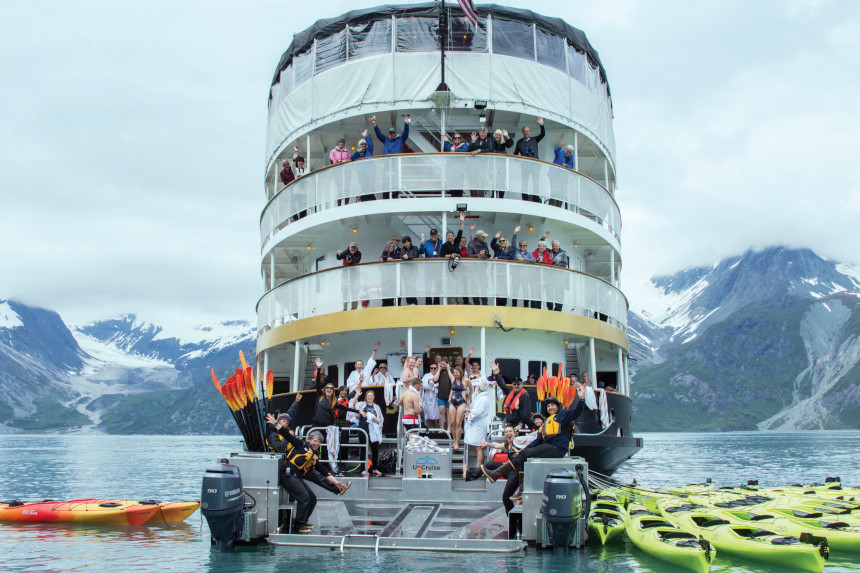
Several days in, while sailing through Glacier Bay, the highlight of many Alaskan cruises, we anchor near the majestic Margerie Glacier. There, not more than 100 yards from the ice, some of us participate in “the polar plunge,” a dive off the aft deck into 40-degree water, followed in my case by an extremely fast exit.
Later in the day, a small group debarks for a hike up a steep rocky outcropping alongside the glacier. From our vantage point, sitting on rocks amid lovely blue and white wildflowers, we spot a pod of three killer whales — two parents and a juvenile — on the hunt. Soon, a large cruise ship pulls into the bay and circles past the glacier. As it departs, we wave at the crowds lining the deck high above the water, capturing the stunning vistas on their phones and video cameras. And we feel privileged that for a short while we’ve been more than just observers of Alaska’s wildest and most beautiful places — we’ve actually touched and experienced them.
If you go: The per-person cost for a one-week UnCruise Adventure ranges from $3,000 to about $7,500. The fee includes delicious food and beverages, including alcohol. (Cocktail hour is a pleasant respite after a day of outdoor activities.) Discounts are available on some trips booked by mid-December. Two other excellent small-ship options with similar amenities and routes are Alaskan Dream Cruises and Lindblad Expeditions.
Steven Slon is the Post’s editorial director.
Featured image: UnCruise passengers hiking above Glacier Bay. (UnCruise)
This article is featured in the September/October 2019 issue of The Saturday Evening Post. Subscribe to the magazine for more art, inspiring stories, fiction, humor, and features from our archives.
Become a Saturday Evening Post member and enjoy unlimited access. Subscribe now

